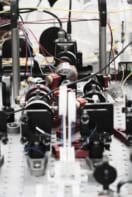An organization representing many of Europe’s leading photonics firms and research labs has drawn up a roadmap recommending that the European Commission (EC) boost its support for research into improving the fabrication of photonic devices based on quantum dots, carbon nanotubes and other nanometre-scale technologies.
The European Roadmap for Photonics and Nanotechnologies is the culmination of a two-year effort coordinated by the Merging Optics and Nanotechnologies (MONA) group, which includes firms such as Aixtron and ASM; labs such as Belgium’s IMEC; and the 78 members of the European Photonics Industry Consortium. The 161-page document offers recommendations for the next 5–10 years of nanophotonics R&D and includes contributions from more than 300 experts in the field.
Key markets
The roadmap calls for the EC’s Seventh Research Framework Programme (FP7) — which coordinates the funding of research in the European Union until 2013 — to support the development of nanoscale technologies for seven key markets for photonics devices.
The need to improve the fabrication of quantum dots is a strong theme of the roadmap, which predicts that these tiny semiconductor devices will have a major impact in almost all photonics markets. It is currently very difficult to make large numbers of quantum dots that are all the same shape and size — something that is crucial for industrial applications.
Quantum dots
One important recommendation is that quantum dots based on compound-semiconductor materials such as gallium arsenide should be developed for us in solar cells. This is because such dots have been shown to be much more efficient at converting light into electricity than standard photovoltaic materials.
Imaging, lighting and data storage are three other applications where quantum dots could have an impact, says the roadmap. And quantum dots and wires integrated with silicon devices will also be important for optical communications, UV sensors and multi-junction solar cells, according to MONA.
Photonic crystals
The report calls for intensified R&D in lighting applications, where technologies such as quantum dots, photonic crystals and nanostructured materials are expected to offer efficiency improvements in light-emitting diodes (LEDs). This is seen as important strategic area for European research, with both Osram of Germany and Philips of the Netherlands playing on the world stage.
Imaging is another field where Europe can already boast a strong research base and global market presence. For visible imaging, the roadmap highlights the need for nanostructured lenses, most likely based on plasmonic devices, to produce CMOS image sensors with ever smaller pixel sizes. And infrared imaging specialists such as Sofradir and CEDIP are hoping to use quantum dot structures in a new generation of detectors that will replace existing quantum-well infrared photodiodes (QWIPs).
Other important areas earmarked for future research funding include microstructured fibres for telecom and sensor applications, organic nanostructures for displays and photovoltaics, and photonic integration for telecom and optical interconnects. Carbon nanotubes also feature as an important nanomaterial for future field-emission displays.



